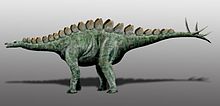- Miragaia (dinosaur)
-
Miragaia
Temporal range: Late Jurassic, 145 Ma
Mounted skeleton Scientific classification 
Kingdom: Animalia Phylum: Chordata Class: Reptilia Superorder: Dinosauria Order: †Ornithischia Suborder: †Stegosauria Family: †Stegosauridae Genus: †Miragaia
Mateus et al., 2009Species: †M. longicollum Binomial name Miragaia longicollum
Mateus et al., 2009Miragaia (named after Miragaia, the parish in Portugal and geologic unit where its remains were found) is a genus of stegosaurid dinosaur. Its fossils have been found in Upper Jurassic rocks in Portugal. Miragaia is notable for its long neck, which included at least 17 vertebrae.
Contents
Discovery
Miragaia is based on ML 433, a nearly complete anterior half of a skeleton with partial skull (the first cranial material for a European stegosaurid). Among the recovered bones were most of the snout, fifteen neck vertebrae (the first two, which articulated with the skull, were absent), the shoulder bones, most of the forelimbs, and thirteen bony plates. ML 433 was found in the Miragaia Unit of the Sobral Formation, Lourinhã Group, which dates to the late Kimmeridgian-early Tithonian (Late Jurassic, approximately 150 million years ago). Octávio Mateus and colleagues described Miragaia in 2009. The type species is M. longicollum ("long neck"). A partial hip and partial vertebrae from a juvenile individual (ML 433-A) were found at the same location, and were also assigned to M. longicollum. Mateus and colleagues performed a phylogenetic analysis and found Miragaia to group with Dacentrurus in a clade Dacentrurinae, the sister group to Stegosaurus.[1]
Description
The most notable feature of Miragaia is its long neck, which was composed of at least 17 vertebrae. This represents the culmination of a trend of longer necks seen in stegosaurians. Additionally, Miragaia had more neck vertebrae than most sauropods, dinosaurs known for their long necks, which contrasts with the traditional view of stegosaurians as low browsers with short necks. Only the Chinese sauropods Euhelopus, Mamenchisaurus, and Omeisaurus had as many neck vertebrae as Miragaia, with most sauropods of the Late Jurassic possessing only 12 to 15. Mateus and colleagues suggested that the long neck either allowed Miragaia to browse at a level that other herbivores were not exploiting, or that the neck arose due to sexual selection.[1]
In sauropods, great neck length was achieved by a combination of three processes: incorporation of back vertebrae into the neck; addition of new vertebrae; and lengthening of the individual neck vertebrae. The long neck of Miragaia appears to have resulted mostly from back vertebrae becoming incorporated into the neck, based on vertebral counts of other stegosaurians. There is currently no evidence that new vertebrae contributed to the neck; instead, the distribution of existing vertebrae in the back and neck changed. There is some evidence for increasing vertebral length in Miragaia and Stegosaurus, but this is equivocal and could be due to post-mortem distortion.[1]
The tip of the beak was toothless, as in Stegosaurus. Both the upper arm and ulna and radius (lower arm bones) are also comparable to those of Stegosaurus. The ribs of the neck vertebrae were fused to the vertebrae. In the pelvis, the pubic bone had an expanded tip, as seen in Dacentrurus. Paired triangular plates ran down the midline of the back.[1] Its total length is estimated at 5.5 – 6 metres (18-20 ft).[1]
See also
References
- ^ a b c d Mateus, Octávio; Maidment, Susannah C.R.; and Christiansen, Nicolai A. (2009). "A new long-necked 'sauropod-mimic' stegosaur and the evolution of the plated dinosaurs" (pdf). Proceedings of the Royal Society B: Biological Sciences 276 (1663): 1815–1821. doi:10.1098/rspb.2008.1909. PMC 2674496. PMID 19324778. http://rspb.royalsocietypublishing.org/content/early/2009/02/21/rspb.2008.1909.full.pdf+html.
External links
Categories:- Stegosaurs
- Jurassic dinosaurs
- Dinosaurs of Europe
- Fossil taxa described in 2009
Wikimedia Foundation. 2010.


